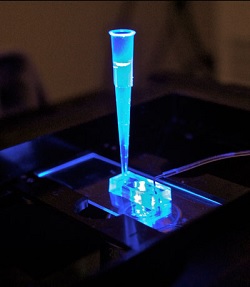 |
| Heart on a chip--Courtesy of UC Berkeley |
A group of bioengineers at UC Berkeley has been hard at work hatching a new "heart-on-a-chip" technology that aims to offer researchers a better, less expensive way to develop new drugs.
Building on years of work in the field of developing organs on a chip, the engineers used human cardiac muscle cells for their one-inch 3-D device, as reported in a study published on Monday, March 9, in the journal Scientific Reports. The cells were created from adult human induced pluripotent stem cells.
This is just the latest in a series of organ-on-chip projects. Last summer the Wyss Institute for Biologically Inspired Engineering at Harvard spun out Emulate with a $12 million series A. And other universities have been involved in the field as well.
Preclinical research is dominated by animal studies, which have proven to be notoriously inefficient in terms of their ability to predict clinical success. As a result, bioengineers see a big future for more precise models like these, and they offer a big vision in terms of what can be accomplished.
"It takes about $5 billion on average to develop a drug, and 60% of that figure comes from upfront costs in the research and development phase," says Kevin Healy, using one in a wide range of controversial estimates on average R&D costs, which typically include a big cost for failed drugs. "Using a well-designed model of a human organ could significantly cut the cost and time of bringing a new drug to market."
The emphasis should be placed on the word "could." The FDA is reviewing the use of organs on a chip but so far has proven reluctant to allow the technology to be used to replace animal studies. Still, given the cost of drug development, even an unofficial tool that could be used to help determine a drug's chances in the clinic would be an advance for drug developers.
- here's the release
- read the research article
Special Report: 3-D printing grows to scale within industry